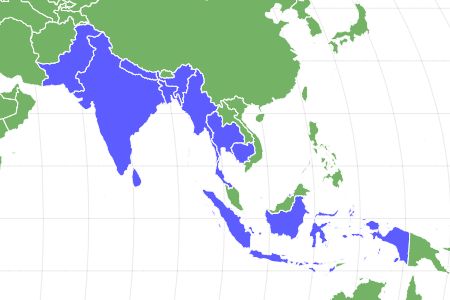Fishing Cat
Prionailurus viverrinus
Scoops fish out of the water using its paw!
Advertisement
Fishing Cat Scientific Classification
- Kingdom
- Animalia
- Phylum
- Chordata
- Class
- Mammalia
- Order
- Carnivora
- Family
- Felidae
- Genus
- Prionailurus
- Scientific Name
- Prionailurus viverrinus
Read our Complete Guide to Classification of Animals.
Fishing Cat Conservation Status
Fishing Cat Facts
- Prey
- Fish, Shellfish, Snakes
- Name Of Young
- Kitten
- Group Behavior
- Solitary
- Fun Fact
- Scoops fish out of the water using its paw!
- Estimated Population Size
- Less than 10,000
- Biggest Threat
- Habitat loss
- Most Distinctive Feature
- Long, stocky body and slightly webbed paws
- Gestation Period
- 63 days
- Habitat
- Variety of wetland habitats
- Diet
- Carnivore
- Average Litter Size
- 2
- Lifestyle
- Nocturnal
- Common Name
- Fishing Cat
- Number Of Species
- 2
- Location
- south-east Asia
- Slogan
- Scoops fish out of the water using it's paw!
- Group
- Mammal
Fishing Cat Physical Characteristics
- Color
- Black
- Olive-Grey
- Skin Type
- Fur
- Top Speed
- 34 mph
- Lifespan
- 10 - 12 years
- Weight
- 5.5kg - 8kg (12lbs - 17.6lbs)
- Length
- 57cm - 85cm (22.4in - 33.4in)
- Age of Sexual Maturity
- 9 - 10 months
- Age of Weaning
- 4 - 6 months
View all of the Fishing Cat images!

The Fishing Cat is a small to medium-sized feline that is natively found throughout a number of countries in Southeast Asia. Unlike other cat species found around the world (with the notable exception of the Jaguar) the Fishing Cat spends most of its life in areas of dense vegetation close to the water and is an excellent swimmer. However, despite its love of water, the Fishing Cat is not particularly specially adapted to its semi-aquatic lifestyle with small teeth that are not well designed for holding onto slippery prey and only slight webbing between the toes on its front paws to help it to negotiate the slippery banks. Although the Fishing Cat is known to still be locally common in certain areas, the global population is severely under threat as it is thought that nearly 50% of their specific wetland habitats are under threat from increasing levels of Human activity throughout much of its natural range.
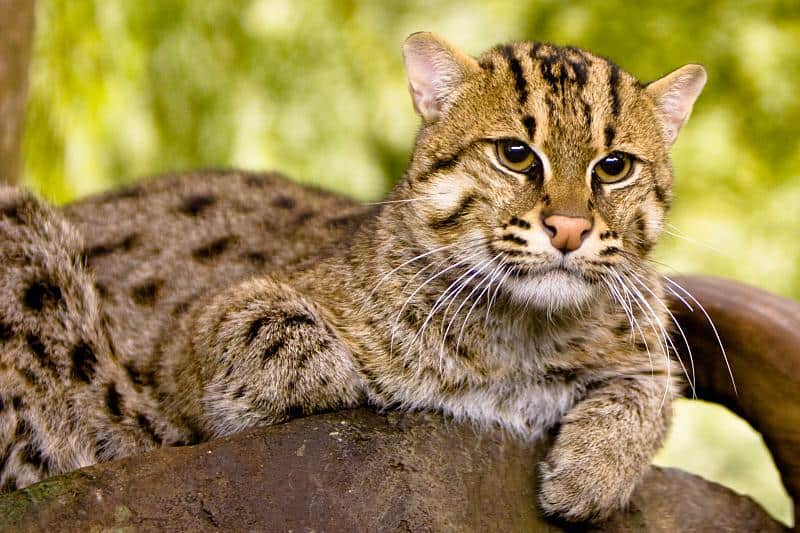
The fishing cat is a small to medium wild cat that has adapted to a semi-aquatic lifestyle.
Anatomy and Appearance
The Fishing Cat has a stocky and powerful body that is quite long in comparison to its short legs. Their short and coarse coat of fur is olive-grey in color and patterned with solid black spots that run the length of their body and often turn into black lines along the spine. The Fishing Cat has a short and flattened tail that is marked with black rings and can be used by the animal when swimming as it works in a similar way to a rudder on a boat, steering the Fishing Cat in the right direction through the water. Their small feet are slightly webbed but not any more so than many other feline species, but one of the biggest differences between the Fishing Cat and its relatives is that their claws are not fully retractable with the tips still sticking out slightly from the protective sheath of skin on their toes (most felines are able to completely retract their claws to prevent them from becoming blunt when they are not in use). Fishing Cats have quite broad heads in relation to their body with small, rounded ears that are black on the back and have a distinctive white spot in the center.
Distribution and Habitat

The fishing cat is native to a number of countries in Southeast Asia including Thailand.
©Thampapon/Shutterstock.com
The Fishing Cat is natively found throughout a number of countries in south-east Asia including Bangladesh, Bhutan, Brunei, Cambodia, China, India, Laos, Malaysia, Myanmar, Nepal, Pakistan, Sri Lanka, Thailand, and Vietnam along with the Indonesian Islands of Java and Sumatra. Although the Fishing Cat appears to have a wide geographical range, due to the fact that they prefer dense, wetland habitats they are only found in certain regions throughout these countries. Ideally, the Fishing Cat inhabits wetland areas where there is plenty of dense vegetation to provide cover both from predators but also to hide from potential prey and can be found in a variety of aquatic regions that include mangrove swamps, rivers, lakes, marshes, reed beds and areas of the forest close to streams. They are, however, severely threatened throughout much of their natural range as wetlands are drained for agriculture or often polluted by industry in the area. It is thought that 98% of the globally significant wetlands throughout southeast Asia are under threat and could even disappear completely.
Behavior and Lifestyle
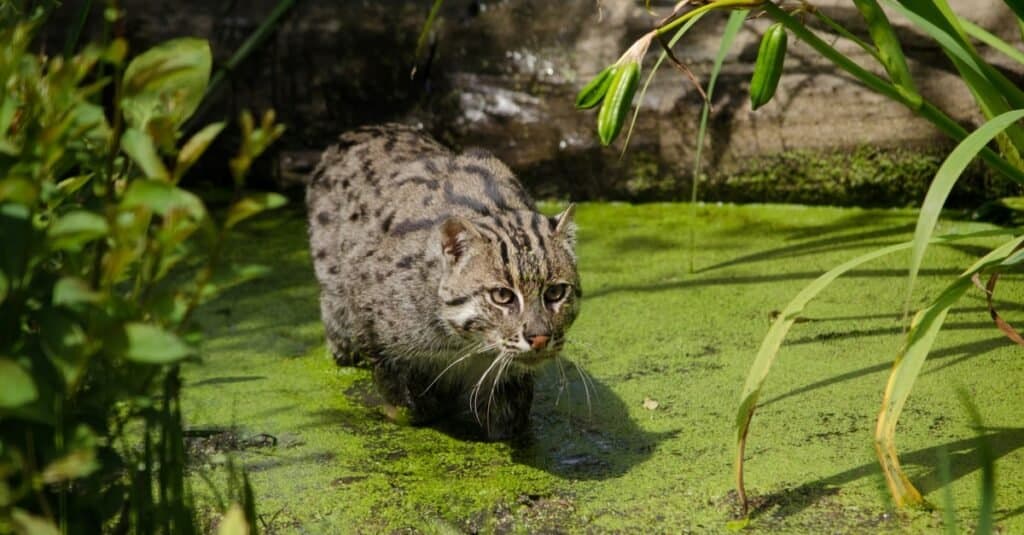
The fishing cat stands out among other types of wild cats because it is a strong, skilled swimmer.
©Gemma Simpson/Shutterstock.com
The Fishing Cat is a nocturnal and solitary hunter that rests amongst dense vegetation during the day before heading to the water at night to find food. They are incredibly strong and capable swimmers and have been known to swim vast distances often in pursuit of a fish trying to get away. Fishing Cats are largely territorial animals that occupy home ranges of up to 22 square kilometers (although the range of a female is often much less), with that of a male Fishing Cat overlapping the patches occupied by a number of females in the area. Fishing Cats are known to be relatively adaptable animals and in certain areas are even known to live around city suburbs with little vegetation and close to Human settlements. Their incredibly elusive and nocturnal lifestyle means that they are often hard to spot but are susceptible to being trapped, poisoned, or accidentally caught in snares that are set up to catch other forest animals, such as Deer.
Reproduction and Life Cycles
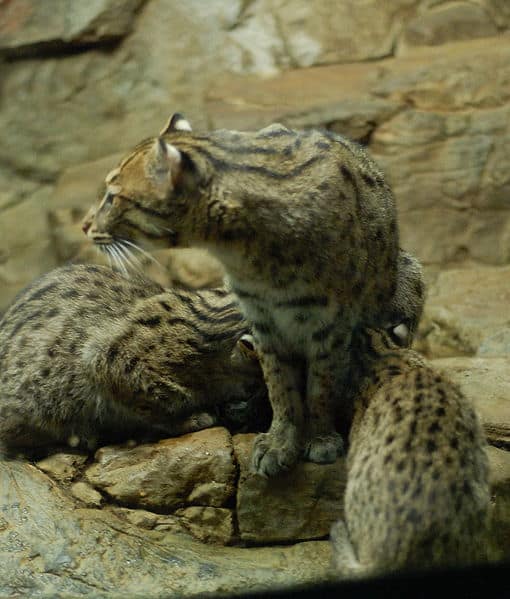
Fishing cat kittens are dependent on their mothers until they are nine months old.
Although little is really known about their breeding or social behavior in the wild, mating is thought to take place in January and February when a female Fishing Cat will call to males in the area, indicating that she is ready to mate. After a gestation period that lasts for between 60 and 70 days, she gives birth to 1 – 4 kittens that weigh about 150 grams and are born blind. Fishing Cat kittens develop relatively slowly at first putting on an average of 11 grams in weight a day and don’t open their eyes until they are just over two weeks old. At around 50 days old the kittens are able to start eating meat but are not weaned for at least another couple of months. Fishing Cats reach their adult size and are able to breed by the time they are nine months old and become completely independent of their mother about a month later when they leave to establish a territory of their own. Although it is thought that it is just the female who rears her young in the wild, captive males have been observed helping her to raise their offspring.
Diet and Prey
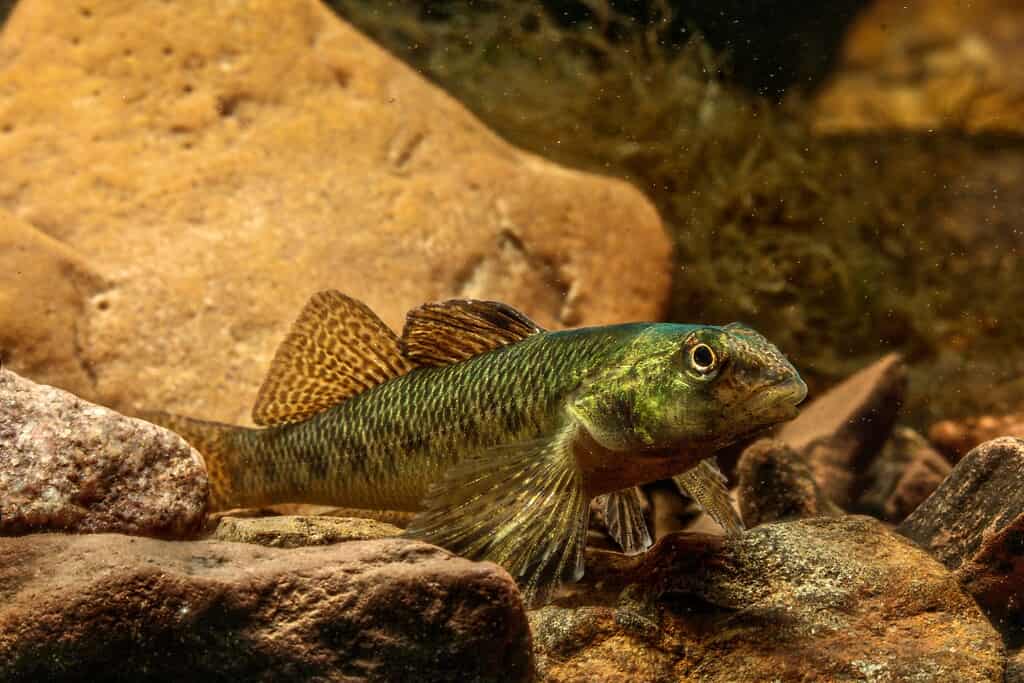
Freshwater fish make up 70% of the fishing cats’ diet – followed by frogs, mollusks, snails, and snakes.
©Sean McVey/Shutterstock.com
The Fishing Cat is a carnivorous animal that only hunts and consumes other animals in order to acquire all of the nutrients that it needs to survive. As its name suggests, aquatic animals make up the bulk of the Fishing Cat’s diet with more than 70% of the food thought to be fish, followed by mollusks, frogs, snails, and snakes that are found in or close to the water. Fishing Cats are also known to hunt small mammals such as mice on land and will even target larger prey like civets, dogs, and livestock in areas close to settlements. Fishing Cats catch their prey in a couple of different ways but tend to dive into the water once a fish has been spotted before catching it in its mouth (they are even known to dive into quite deep water and can surface under aquatic birds to catch them). The other method they use involves them sitting at the water’s edge either on the bank or rock and using their paw, they lightly tap the surface in a way that mimics an insect to attract fish. Once it is close enough the Fishing Cat then scoops the fish out of the water using its paw and flicks it onto dry land before eating it.
Predators and Threats
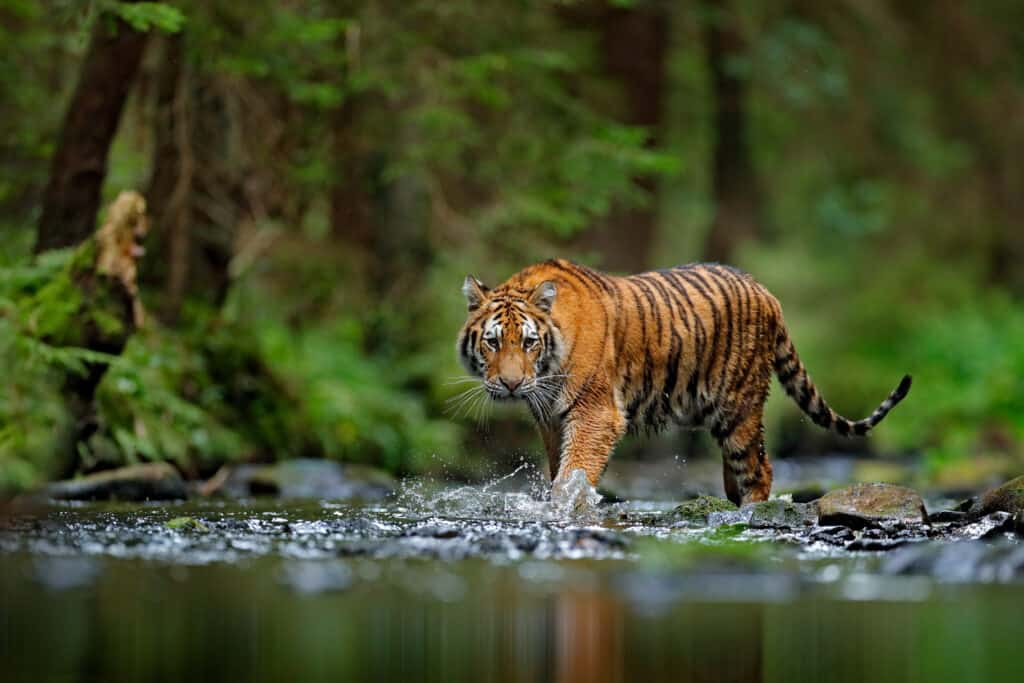
Tigers are a threat to the fishing cat in areas where they share habitats.
©iStock.com/Ondrej Prosicky
Due to the powerful build and aquatic nature of the Fishing Cat, they are thought to have very few (if any) real natural predators in the wild. However, the Fishing Cat is often found in areas where they share their habitats with larger carnivorous mammals such as tigers and bears which could be of threat to them. People are the biggest threat to the Fishing Cat as they have not only destroyed much of their unique wetland homes with increasing levels of industrial and commercial activity but they have also been known to hunt Fishing Cats over the years for their meat and fur. Despite now being a protected animal species, large seizures of Fishing Cat skins at local markets still occur which indicates that poachers are still decimating populations, particularly in certain areas. Another problem for Fishing Cats caused by Humans is the fact that in areas close to growing settlements, locals are often overfishing in the nearby lakes and rivers which means that the food available for the Fishing Cats is also declining fast.
Evolution
Prionailurus diverged from a common ancestor between 8.76 to 4.53 million years ago. The rusty-spotted cat (P. rubininosus) was believed to be the first cat to genetically diverge, followed by the flat-headed cat (P. planiceps) and then the fishing cat (P. viverrinus). The fishing cat diverged together with the leopard cat between 4.25 to 0.02 million years ago.
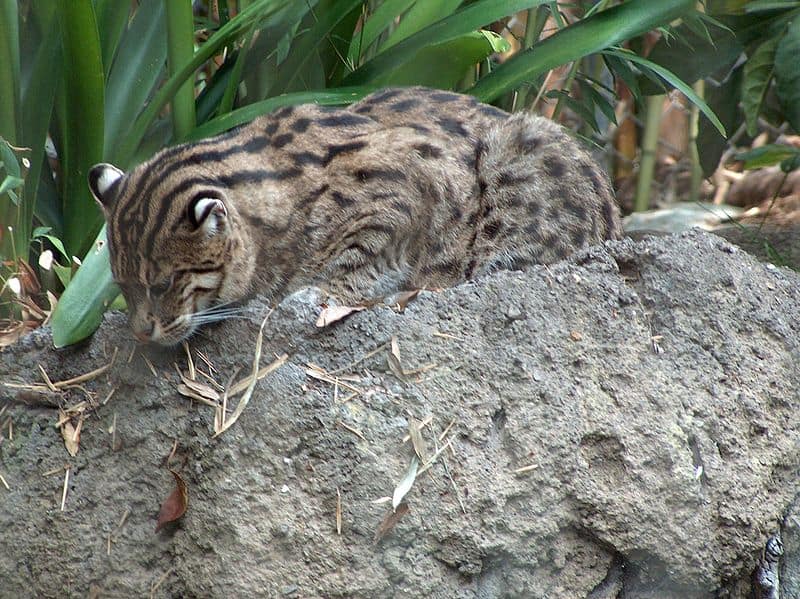
The fishing cat and the leopard cat diverged together and are closely related.
The Fishing Cat was first described scientifically by Edward Turner Bennet in 1833 and was given its scientific name with the last past meaning “civet-like”. Although they are not closely related at all, the Fishing Cat has a long, stocky body with short legs and a short tail which makes it look remarkably similar to these small carnivores. Although Fishing Cats tend to be most commonly found in a variety of watery lowland habitats, they are also known to inhabit areas at elevations of up to 5,000 ft depending on the waterways in the area (a small population is actually found in parts of the Himalayas). The Fishing Cat is classed as part of the Leopard Cat lineage. Other members of this feline group include the Leopard Cat itself, the Pallas Cat, and the Flat-Headed Cat, to which the Fishing Cat is most closely related.
Species
There are two subspecies of the fishing cat with geographical differences:
- Prionailurus viverrinus viverrinus – can be found in India, Sri Lanka, Pakistan, Bangladesh, Indochina, Nepal, and Bhutan.
- Prionailurus viverrinus rhizophoreus – can be found in Java.
Relationship with Humans

Fishing cats are hunted for their fur and their habitats are shrinking due to human activity.
Due to the fact that the Fishing Cat is seldom seen in the wild as they are nocturnal and their preferred habitats would have been quite inaccessible to people for some time, until the middle of the last century, they were locally common throughout much of their native regions. However, the hunting of them by people for their meat and fur has obliterated populations in many areas, and even today, they are still illegally killed in their hundreds to sell their skins on the black market. The biggest problem facing the Fishing Cat though is the drastically increasing levels of Human activity in their natural environments that is severely affecting not just the Fishing Cats, but also the incredibly unique and bio-diverse wetland habitats in which they live. Water draining for agriculture and to make way for roads, growing Human settlements, and high levels of an industry that pollute the water with toxic substances has reduced their once vast natural range by nearly 50%.
Conservation Status and Life Today

The fishing cat is now listed as an endangered species by the IUCN.
Today, the Fishing Cat is listed by the IUCN as an animal species that is Endangered in its natural environment and could therefore be threatened with extinction in the not-too-distant future. The biggest threat to the Fishing Cat is habitat loss with many of their remaining pockets of wetland homes now considered to be protected areas (illegal activity in these areas though is still contributing to the loss of species in these regions). Conservation projects have been set up in a number of areas to protect both the Fishing Cats and their unique wetland habitats and the hunting and trade of the species are now illegal. Poaching, however, still continues with skins still being seized from markets in the far east.
View all 91 animals that start with FFishing Cat FAQs (Frequently Asked Questions)
What's the difference between fishing cats and minks
Fishing cats and minks look very similar to one another. However, the primary difference is that fishing cats are substantially larger than minks. Fishing cats are also mostly located in Canada while minks have a range that extends further south.
Are Fishing Cats herbivores, carnivores, or omnivores?
Fishing Cats are Carnivores, meaning they eat other animals.
What Kingdom do Fishing Cats belong to?
Fishing Cats belong to the Kingdom Animalia.
What phylum to Fishing Cats belong to?
Fishing Cats belong to the phylum Chordata.
What family do Fishing Cats belong to?
Fishing Cats belong to the family Felidae.
What order do Fishing Cats belong to?
Fishing Cats belong to the order Carnivora.
What type of covering do Fishing Cats have?
Fishing Cats are covered in Fur.
What genus do Fishing Cats belong to?
Fishing Cats belong to the genus Prionailurus.
Where do Fishing Cats live?
Fishing Cats live in southeastern Asia.
In what type of habitat do Fishing Cats live?
Fishing Cats live in a variety of wetland habitats.
How many babies do Fishing Cats have?
The average number of babies a Fishing Cat has is 2.
What is an interesting fact about Fishing Cats?
Fishing Cats scoop fish out of the water using their paws!
What is the scientific name for the Fishing Cat?
The scientific name for the Fishing Cat is Prionailurus viverrinus.
What is the lifespan of a Fishing Cat?
Fishing Cats can live for 10 to 12 years.
How many species of Fishing Cat are there?
There are 2 species of Fishing Cat.
What is the biggest threat to the Fishing Cat?
The biggest threat to the Fishing Cat is habitat loss.
How many Fishing Cats are left in the world?
There are less than 10,000 Fishing Cats left in the world.
How fast is a Fishing Cat?
A Fishing Cat can travel at speeds of up to 34 miles per hour.
How to say Fishing Cat in ...
Thank you for reading! Have some feedback for us? Contact the AZ Animals editorial team.
Sources
- David Burnie, Dorling Kindersley (2011) Animal, The Definitive Visual Guide To The World's Wildlife
- Tom Jackson, Lorenz Books (2007) The World Encyclopedia Of Animals
- David Burnie, Kingfisher (2011) The Kingfisher Animal Encyclopedia
- Richard Mackay, University of California Press (2009) The Atlas Of Endangered Species
- David Burnie, Dorling Kindersley (2008) Illustrated Encyclopedia Of Animals
- Dorling Kindersley (2006) Dorling Kindersley Encyclopedia Of Animals
- David W. Macdonald, Oxford University Press (2010) The Encyclopedia Of Mammals
- Fishing Cat Facts, Available here: http://bigcatrescue.org/2011/fishing-cat-facts
- Fishing Cat Research, Available here: http://www.fishingcatproject.info/
- Fishing Cat Conservation, Available here: http://www.iucnredlist.org/apps/redlist/details/18150/0

